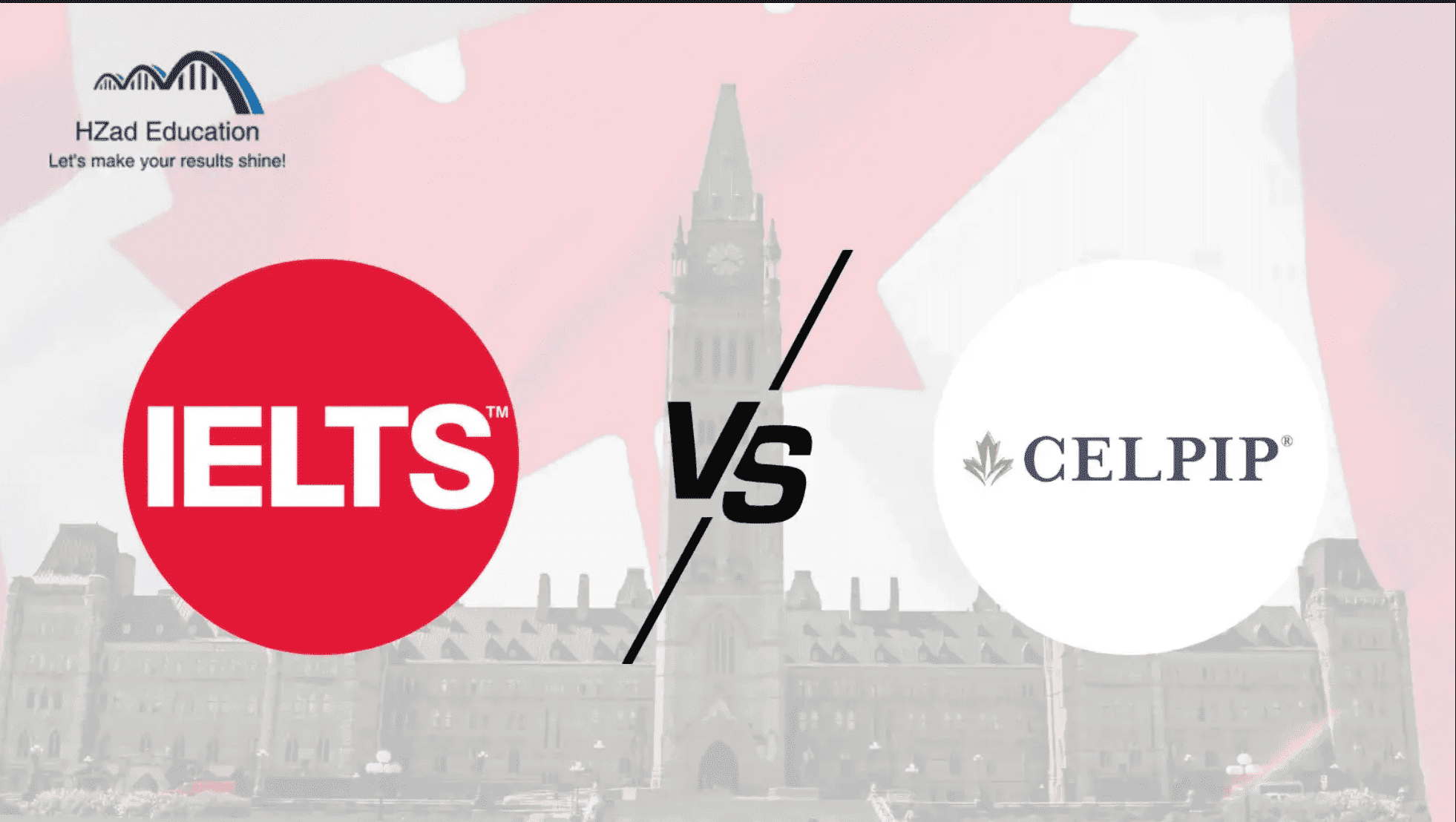
IELTS 7+ Bands in 15 Hours: Buy our course Today!
CELPIP Top-Selling CLB 10 Course: Buy our Course Today!
Use the coupon code CLB10 to receive a MASSIVE 25% discount!
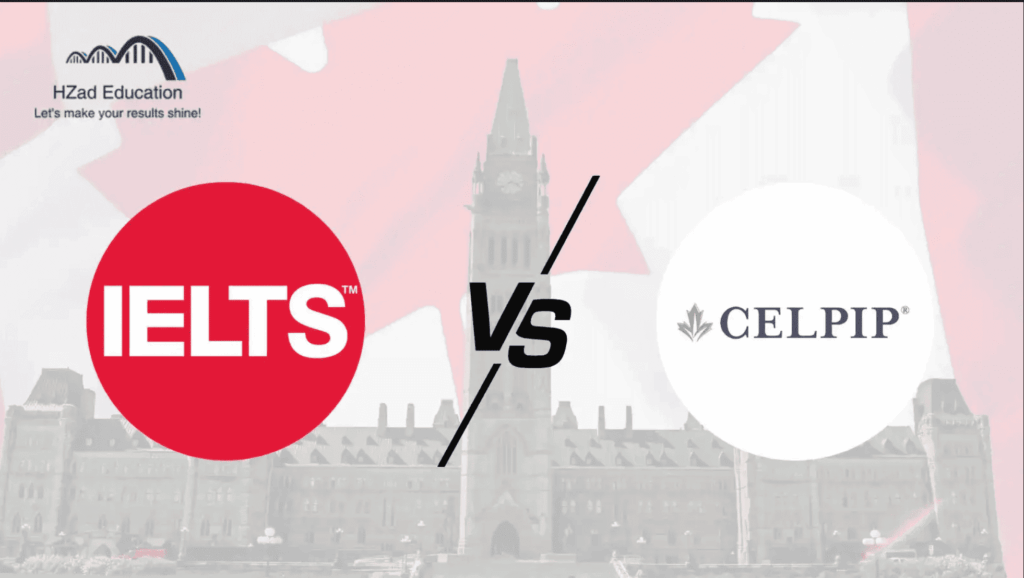
CELPIP vs IELTS: Which Test is Right for You?
CELPIP is better suited for Canadian immigration, while IELTS is ideal for global academic and migration purposes. Both tests assess English language proficiency across Listening, Reading, Writing, and Speaking, but they differ in format, delivery mode, and recognition scope.
CELPIP is fully computer-based and tailored to Canadian contexts, whereas IELTS offers both paper and digital formats with global content and international acceptance. Understanding these differences helps test-takers choose the right exam based on their location, goals, and institutional requirements. Selecting the appropriate test ensures your results meet the expectations of immigration bodies, universities, or employers.
What Are CELPIP and IELTS?
The CELPIP and IELTS are internationally recognized English proficiency tests for study, work, and immigration purposes. These tests evaluate an individual’s language proficiency in listening, reading, writing, and speaking.
However, the delivery mode, recognition, test format, structure, and scoring format vary. Likewise, the selection between these depends on test goals, geographic location, and personal preference.
Overview of the CELPIP Test
Developed by Paragon Testing Enterprises, the CELPIP Test (Canadian English Language Proficiency Index Program) is a formally accepted language proficiency exam prioritized by Immigration, Refugees, and Citizenship Canada (IRCC). Offered in two formats, CELPIP General and CELPIP General LS, these tests determine the eligibility requirements of applicants for Canadian PR and Canadian Citizenship.
CELPIP Overview Infographic: Include a simple diagram of the test’s components and their corresponding skills assessed.”

Overview of the IELTS Test
The IELTS (International English Language Testing System) is a band-based, globally accepted English language assessment test. Available in two versions, IELTS Academic and IELTS General Training, this standardized test can be given on paper or a computer and is accepted by more than 12,500 organizations, including universities, immigration authorities, and professional institutions across 140+ countries.
IELTS Overview Infographic: Provide a diagram illustrating the two test versions and their components (Listening, Reading, Writing, and Speaking).
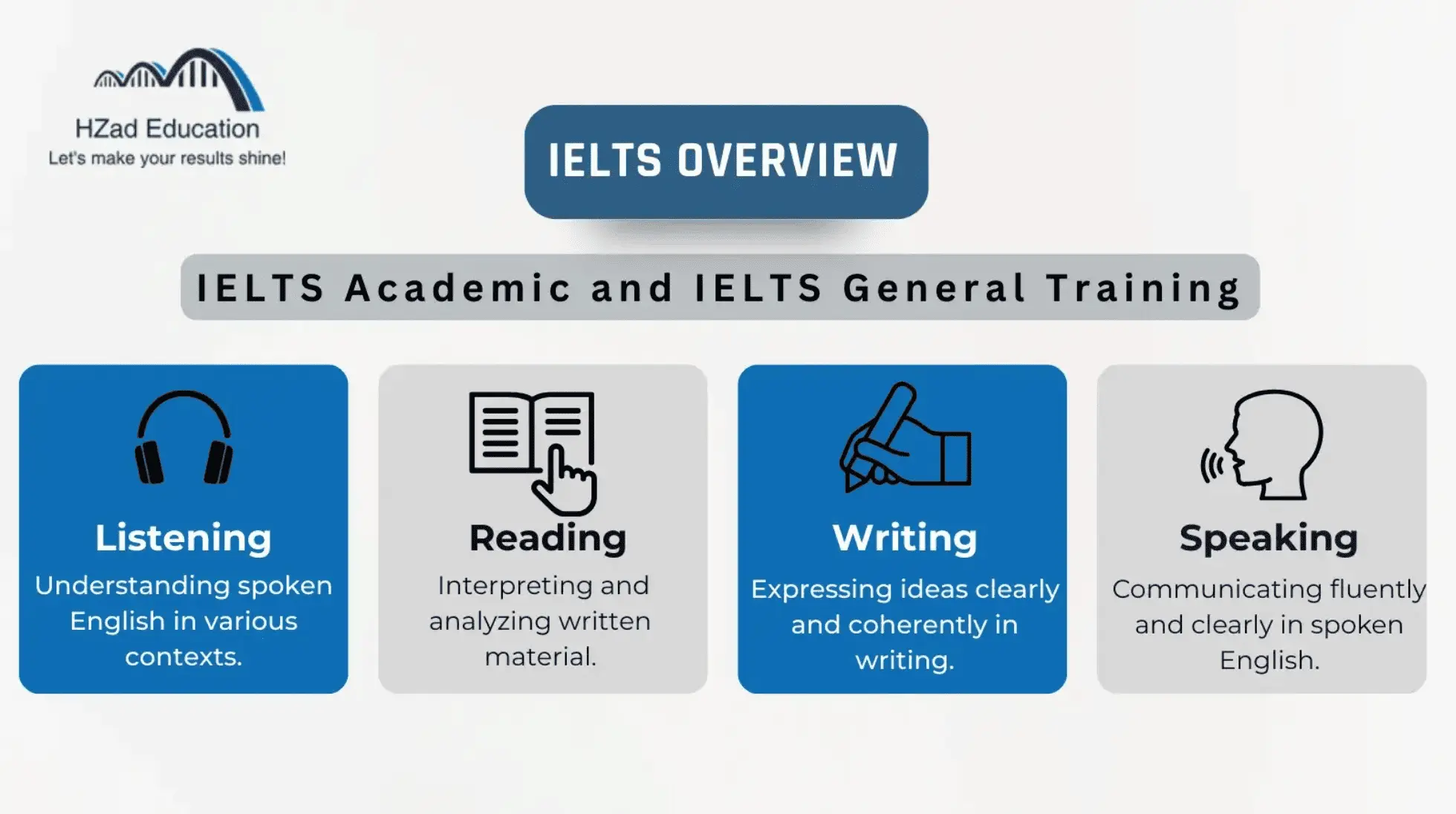
CELPIP vs IELTS: Test Format and Structure
The CELPIP and IELTS assessments evaluate individuals’ English proficiency in listening, reading, writing, and speaking. Although the intent is the same, these test formats differ in delivery mode, task types, number of questions, and evaluation methods. Understanding the structural difference is vital for choosing the right test for your goals.
Listening Test Comparison
The listening section of the CELPIP test contains six parts (38 questions in total), including multiple audio clips related to problem-solving, daily life conversation, new items, and discussion. These audio recordings feature Canadian accents and North American contexts, such as conversation in a public place or problem-solving scenarios. Test takers must respond to the matching and multiple-choice questions on their screens within 46 to 55 minutes.
Meanwhile, the IELTS listening part contains four recordings of native English speakers that candidates must listen carefully to answer a series of multiple-choice, matching, plan/map/diagram labelling, form/note/table/flow-chart/summary completion, and sentence completion questions. Participants must answer the 40 questions in 30 minutes. The test allocates an extra 10 minutes to transfer their answers to the answer sheet.
Speaking Test Comparison
The speaking section of the CELPIP test includes eight tasks. Candidates must give advice, describe a scene, compare, make predictions, and express opinions within 15 to 20 minutes. They should reply to the prompts through a computer microphone. Paragon records the test audio of participants, which is later evaluated by trained raters.
In contrast, the IELTS speaking test is a face-to-face interview in which a certified examiner conducts a three-part exam. The prompts include a personal introduction, a discussion on a particular topic, and detailed questioning of the topic covered in the second part. The speaking part lasts 11 to 14 minutes and assesses the test takers’ ability to communicate opinions, interact in real-time, and speak about a topic within a given timeframe.
Reading Test Comparison
The CELPIP test’s reading test contains 38 questions distributed across four parts. The questions are designed to evaluate the participants’ literal understanding, logical reasoning, and vocabulary interpretation. The test features emails, online forum posts, and double passages, which test takers must interpret and complete multiple-choice, information-matching, and meaning-identification tasks within 43 to 56 minutes.
On the other hand, the reading part of the IELTS test includes 40 questions. Applicants must solve multiple-choice questions, give short answers to open questions, match headings to written texts to diagrams or charts, and fill in the gaps. Candidates must finish this part of the test within 60 minutes. Academic test-takers read journal articles and research abstracts, while General Training candidates read social notices, advertisements, and instruction manuals.
Writing Test Comparison
The CELPIP writing test includes writing an email and responding to survey questions. Test takers must finish this test session in 53 minutes. They must illustrate their capability to create well-organized, clear, grammatically correct, and language-appropriate content within the Canadian context.
Alternatively, in the IELTS writing test, participants must answer two questions within 60 minutes. For the General Training version, Task 1 is a 150-word letter, while Task 2 is a 250-word structured essay. The Academic version features a graph/chart description of 150 words in Task 1 and a 250-word essay in Task 2. The second task for both versions requires test takers to present their viewpoint.
CELPIP vs IELTS: Test Duration and Timing
CELPIP and IELTS are different in terms of total test duration, sectional time, and whether the test is one sitting or multiple days. Understanding the timing is key to preparation and performance as it affects how you manage your time in the exam.
Below is a breakdown of the duration and time management of both tests.
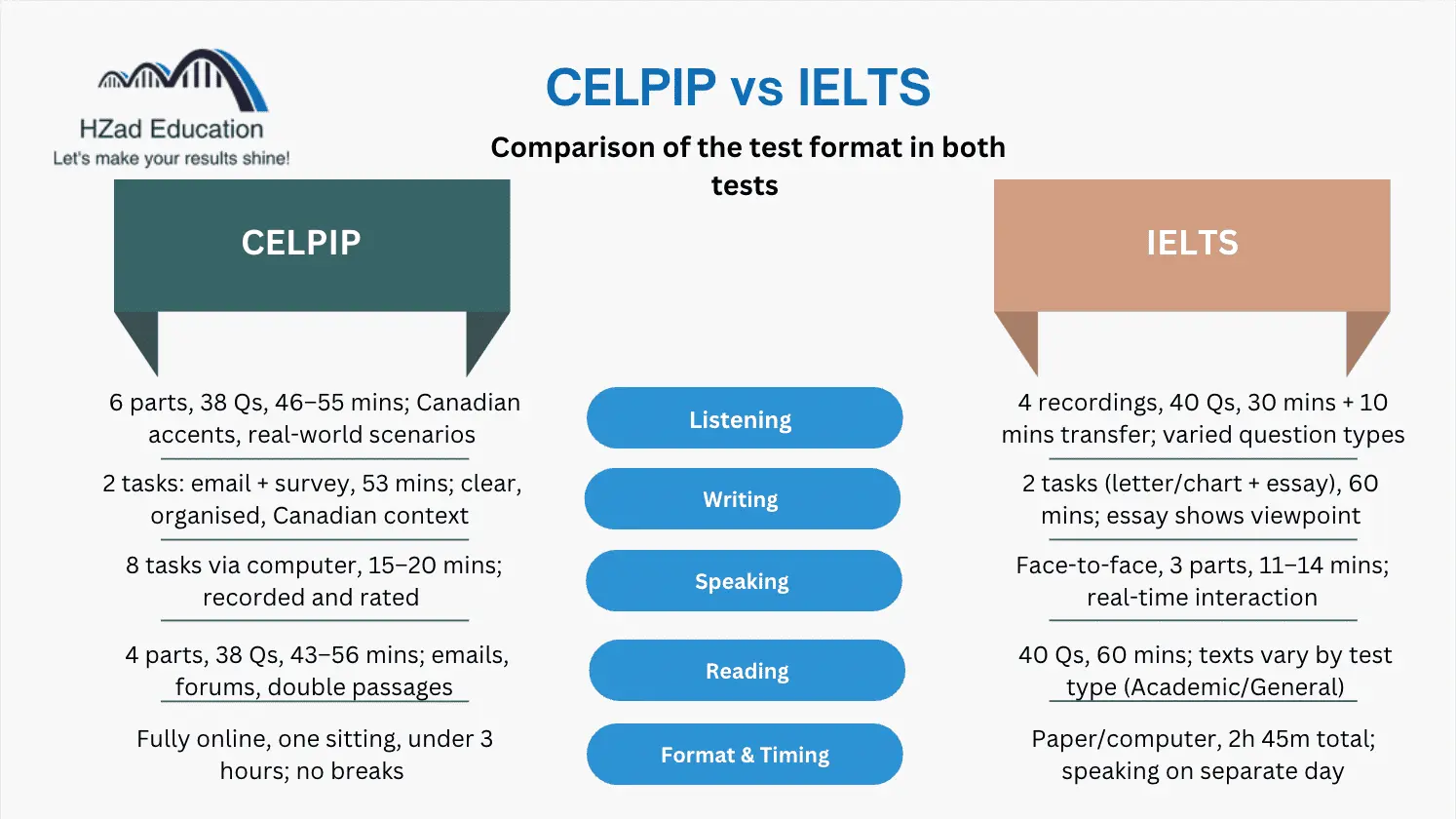
CELPIP Test Timing
The CEPIP test is fully computerized and finishes in one sitting under 3 hours. Each test section is time-bound and follows a fixed sequence. There are no breaks between sections.
- Listening: 46-55 minutes
- Reading: 43-56 minutes
- Writing: 53 minutes
- Speaking: 15-20 minutes
IELTS Test Timing
The total duration of the IELTS test is 2 hours and 45 minutes. The three sections (reading, listening, and writing) are conducted in one day, whereas the speaking section is conducted on a different day. This format offers more flexibility but may require logistical coordination for some candidates.
- Listening: 30 minutes
- Reading: 60 minutes
- Writing: 60 minutes
- Speaking: 11-14 minutes
CELPIP vs IELTS: Scoring System
The CELPIP test uses a point scale system linked directly to the Canadian Language Benchmarks (CLB), whereas IELTS uses a band system that reflects globally standardized proficiency levels.
CELPIP Scoring Breakdown
CELPIP test uses a 1-12 point scale system, with each level corresponding to a specific CLB. All four components are scored individually, and the results are released within 3 to 4 business days. Applicants can log into their CELPIP account and view their results.
Here is a CELPIP scoring breakdown and its interpretation:
- CELPIP Level 12: Advanced proficiency, indicating nearly native-level fluency
- Level 9–11: Competent to advanced user, meaning adequate for most work and immigration scenarios
- Level 7–8: Moderate proficiency, sufficient for general communication
- Level 5–6: Basic working knowledge, which may not meet all immigration standards
- Level 1–4: Minimal to limited understanding of English
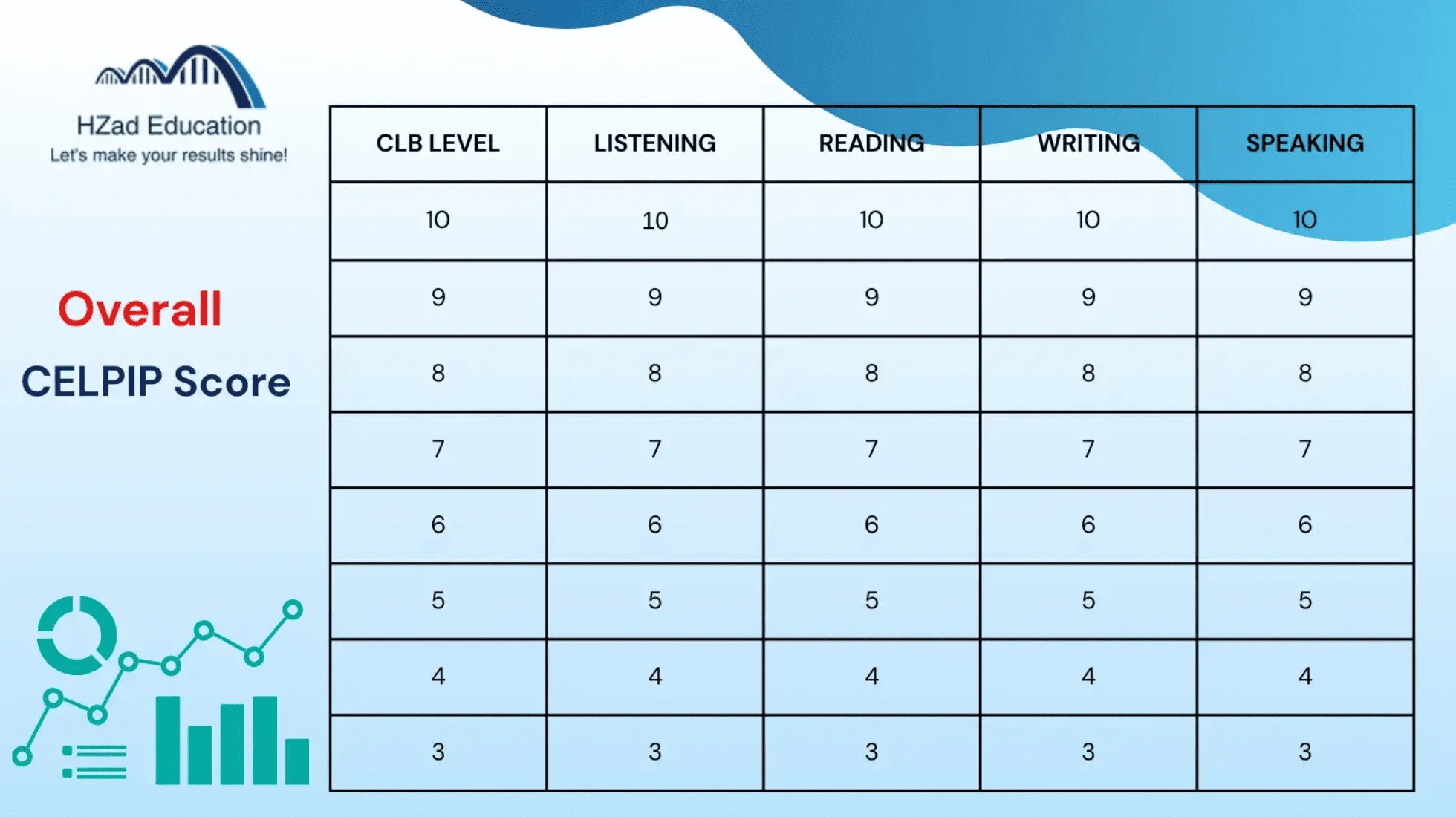
IELTS Scoring Breakdown
The IELTS test uses a 9-band scale. Handled by a collaboration of the British Council, IDP: IELTS Australia and Cambridge Assessment English, they assign scores to each section and calculate the average to provide the overall band score.
Below is the band-wise interpretation of the IELTS score:
- Band 9: Expert user – full operational command with accurate and fluent use of English
- Band 8: Very good user – occasional unsystematic inaccuracies with the ability to handle complex and detailed argumentation
- Band 7: Good user – occasional misunderstandings in unfamiliar situations, but with excellent understanding of complex language and detailed reasoning
- Band 6: Competent user – effective communication with some errors, along with a reasonable understanding of complex language
- Band 5: Modest user – partial command, frequent breakdowns, with basic communication skills
- Band 4: Limited user – basic competence, frequent difficulty in understanding and expressing
- Band 3: Extremely limited user – conveys and understands only the general meaning
- Band 2: Intermittent user – severe communication difficulty in spoken and written English
- Band 1: Non-user – no real ability to use the language
- Band 0: Did not attempt the test

CELPIP vs IELTS: Difficulty Level
The difficulty level of CELPIP and IELTS depends on personal preference, the candidate’s background, test objectives, and language familiarity. Some test takers find one easier due to familiarity with accents, while others may struggle with certain task types or speaking formats.
For example, Canadian residents familiar with the Canadian accent and localized content are bound to find CELPIP easier than IELTS. Meanwhile, casual English-speaking applicants may think the opposite due to unfamiliarity with Canadian conversation and dialect.
Is CELPIP Easier Than IELTS?
Based on our candidates’ experience and reviews, CELPIP is easier than IELTS for candidates living in Canada, as the test format includes localized Canadian content.
Since CELPIP relies on computerized mechanics, it eliminates the pressure of facing a live examiner and provides a more comfortable environment for the participants, especially in the speaking section. Also, the use of Canadian accents, task clarity, and functional English tasks makes it more intuitive for individuals from Canadian society.
However, candidates aiming for international academic progress may find IELTS more realistic due to its inclusion of global contexts and formal, structured, and diverse content.
CELPIP vs IELTS: Cost and Availability
When deciding between CELPIP and IELTS, price and availability are key. Each language assessment has its pricing, add-ons, and regional availability, further influencing the test taker’s decision. Both are competitively priced, but geographic reach, rescheduling flexibility, and score reporting policies may sway one’s choice.
CELPIP Test Fees
The CELPIP General costs CAD 290 plus taxes, while the CELPIP General LS costs CAD 195 plus taxes. The General test includes all four sections, while the LS version examines the listening and speaking parts only, hence the lesser amount.
Here is the list of additional charges related to the CELPIP test:
-
- CELPIP Rescheduling: The first transfer is free, but the subsequent transfer costs CAD 50 if made within 7 calendar days.
- Test Cancellation: If the request is submitted at least 7 calendar days before the original date, Paragon will grant a 50% refund on the test registration fee.
- Extra CELPIP score reports: CAD 20.00
- Re-evaluation: Starting at CAD 55.00 (valid within six months), depending on the test section
IELTS Test Fees
The fee structure for the IELTS test ranges between CAD 339 to CAD 365 plus taxes, depending on your choice of test format. If you choose IELTS on the computer, it will cost less than IELTS on paper.
Other costs related to IELTS are given below:
- IELTS Rescheduling: CAD 85.00 (at least 14 days before the test date)
- Test Cancellation: 75% refund if cancellation is made before 14 days of the test date, 50% refund if request is made between 14 and 5 days, and no refund if request is initiated within 5 days of the test.
- Admin fee for result re-evaluation: CAD 25.00
Test Availability and Locations
CELPIP is available in 120 test centres across Canada, while IELTS is available in over 150 test centres across 57 cities in Canada. Both English language proficiency tests are available in all major Canadian cities with multiple slots and diverse periods.
Speaking about global exposure, CELPIP offers its test sittings in 32 countries, including the USA, the UK, Australia, India, China, Singapore, Japan, Mexico, New Zealand, and Germany. In contrast, IELTS is available at over 4000 test locations across 140 countries.
Infographics: Image with different costs of CELPIP and IELTS
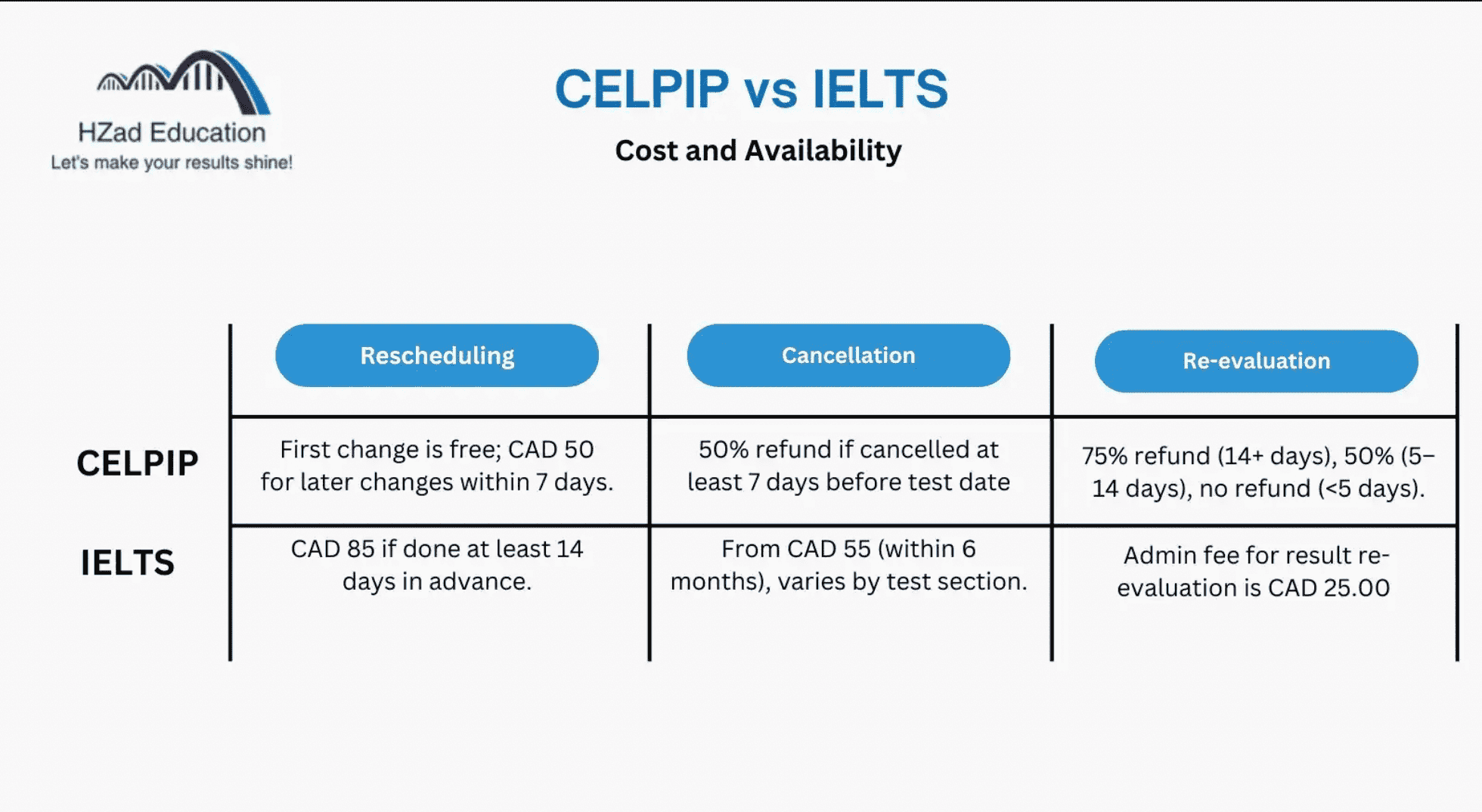
Which Test Is More Widely Recognized: CELPIP or IELTS?
IELTS is more widely recognized than CELPIP, with acceptance by over 12,500 institutions and availability at more than 4,000 test locations across 140 countries.
Accepted by Immigration, Refugees and Citizenship Canada (IRCC) and some Canadian professional licensing bodies, CELPIP’s recognition is largely limited to Canada. In contrast, IELTS is approved by major immigration authorities, academic institutions, and employers globally, including in the UK, Australia, New Zealand, and the USA.
For candidates seeking international study, employment, or migration, IELTS offers significantly broader reach and institutional acceptance compared to CELPIP, which is best suited for those targeting Canadian immigration pathways.
How Can I Prepare for CELPIP vs IELTS?
The best way to prepare for CELPIP and IELTS is to use official practice materials, understand each test’s format, and develop skills tailored to their specific task types and scoring systems.
Although both tests evaluate listening, reading, writing and speaking, the test method of CELPIP (computer-based with a Canadian context) and IELTS (paper or computer-based with one-on-one speaking) varies. Therefore, candidates should follow a different approach and adpt different strategies and resources while preparing for these tests.
CELPIP Preparation Tips
To prepare effectively for CELPIP, focus on building functional English skills relevant to Canadian scenarios and mastering the digital interface used during the test. You can follow these tips and prepare strategically to score better in your CELPIP exam:
- Use official CELPIP practice tests from Paragon Testing Enterprises for accurate test simulation.
- Practice speaking tasks by recording responses and reviewing clarity, tone, and structure.
- Improve email writing and survey responses through timed writing drills using realistic prompts.
- Listen to Canadian news, public radio, and podcasts to get used to Canadian accents and everyday language.
- Familiarize yourself with the scoring scale (1–12) and how it maps to Canadian Language Benchmarks (CLB).
Ready to go beyond basic practice? Start with 5 free CELPIP tests—then level up with our complete CELPIP 10+ Score Course. Get expert-tested writing and speaking templates, tutor feedback with AI scoring, and 800+ CELPIP-targeted words plus timing strategies designed for high scores. Start free and unlock our CELPIP 10+ Score Course.
IELTS Preparation Tips
To prepare for the IELTS exam, especially for global academic or immigration purposes, focus on structured practice with varied accent exposure, formal writing styles, and guided instruction. Below are some IELTS preparation tips that will surely help on your test day:
- Review the test format using official guides from the British Council, IDP, or Cambridge IELTS.
- Improve academic vocabulary and practice writing essays, letters, or graph descriptions depending on your chosen module (Academic or General Training).
- Listen to a wide range of English accents and practice note-taking during listening exercises.
- Record and review your Speaking responses, or engage in mock interviews with a coach.
- Take full-length, timed mock tests and use the IELTS 9-band scoring system to benchmark your progress.
Tried the free IELTS tests? Now train like a top scorer with our full IELTS 7+ Band Course. Get insider strategies used by Band 8+ scorers, high-scoring templates, grammar and paraphrasing tools, 400+ IELTS-specific words, and a fast-track crash course built for better results. Upgrade from practice to performance with our IELTS 7+ Band Course.
Which Test Should You Take? CELPIP vs IELTS Decision Guide
The right test to take depends on your immigration, study, or work goals, as well as your location and test format preferences. Both CELPIP and IELTS are valid English language assessments, but they differ in structure, delivery, and recognition. This guide will help you evaluate key decision points and choose the test that aligns best with your needs and circumstances.
Factors to Consider: Test Goals and Location
When deciding between CELPIP and IELTS, consider the following factors:
- Purpose of the test: Select CELPIP for Canadian immigration (e.g., PR or citizenship). Choose IELTS for international education, work visas, or global immigration.
- Location and availability: CELPIP is primarily available in Canada, the USA, India, and 30 other countries. IELTS is available in 140+ countries at over 4,000 test centers worldwide.
- Test format preference: CELPIP is fully computer-based, including Speaking. IELTS offers both paper-based and computer-based options, with face-to-face Speaking.
- Recognition scope: CELPIP is accepted by Canadian institutions and the IRCC. IELTS is accepted by 12,500+ institutions worldwide, including immigration agencies, universities, and professional bodies.
- Language context and accents: CELPIP uses Canadian English and familiar local contexts. IELTS includes international English with a mix of British, Australian, and North American accents.
Result delivery: CELPIP results are usually available within 3–4 business days. IELTS results take 3–13 days, depending on whether the test was computer-based or paper-based.

